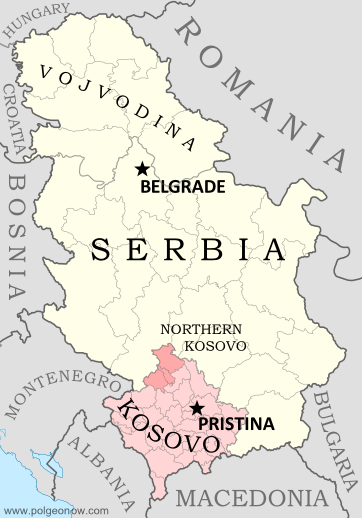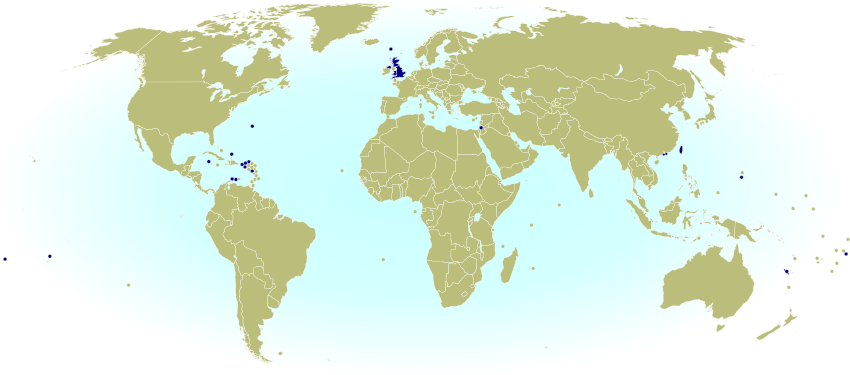A world political map published by the U.S. government (public domain) One of the most basic questions for map-lovers is, "How many countries are there in the world?" But anyone who replies assuredly with a simple number is leaving out part of the story. The fact is, the answer depends strongly on how you define "country".
Here are six of the most common answers, each correct in its own way:
195 Sovereign States According to the U.N.
"Country" and "nation" are often casual words for what political scientists call a "sovereign state", meaning a place with its own borders and completely independent government. The question of which places count as sovereign states can be controversial, but for starters we can count all the member or observer countries of the United Nations (U.N.).
U.N. Members: 193
U.N. Observer States: 2
Total: 195
These countries mostly all accept each other as sovereign states, and they're the ones you'll see on most world maps and many lists of the world's countries. Most of the countries you've ever heard of are probably members of the U.N., and the two U.N. Observer State countries are Vatican City (represented by the Holy See) and Palestine. If you want to know the names of all 195, Wikipedia has a complete list.
The last addition to the list was in 2012, when Palestine became a U.N. Observer State, and the last country to join the U.N. as a full member was South Sudan in 2011.
Note: Palestine's acceptance as a U.N. Observer State was controversial, so some lists may still only include 194 countries.
201 States With At Least Partial Recognition
Several more country candidates are left out of the U.N. itself, but are still officially acknowledged by at least one U.N. member (this official acceptance is called "diplomatic recognition"). These controversial countries are usually labeled on world maps as disputed territories or special situations, if they're on the map at all.
 |
| Kosovo is claimed by Serbia, but recognized as independent by over 100 countries. |
U.N. Observer States: 2
States With Partial Recognition: 6
Total: 201
The six states with partial recognition are Taiwan, Western Sahara, Kosovo, South Ossetia, Abkhazia, and Northern Cyprus. All of these are claimed as parts of other countries, but aren't actually controlled by them (at least not completely). The number of U.N. members recognizing them varies, from just one for Northern Cyprus, to over 100 for Kosovo.
A few lists also include the Cook Islands and Niue as partially-recognized states. These two places sometimes act like independent countries, but they've never actually declared independence or tried to join the U.N., and are usually considered overseas territories of New Zealand.
204-207 De Facto Sovereign States
But wait, there's more! The six partially recognized countries aren't the only breakaway states with full self-governance. There are at least three more declared countries that aren't recognized by any U.N. members at all, but still operate independently from the countries that claim them. These are often called "de facto" sovereign states, a fancy Latin way of saying that they're independent countries in actual fact, even if not on paper.
U.N. Members: 193
U.N. Observer States: 2
States With Partial Recognition: 6
Unrecognized De Facto Sovereign States: 3 to 6 (see below)
Total: 204 to 207
The three places most often considered de facto independent countries are Nagorno-Karabakh, Transnistria, and Somaliland. And since 2014 there are three more contenders for the list: the Islamic State, the Donetsk People's Republic, and the Lugansk People's Republic. But because these last three are located in active war zones and have only limited government structures, there's some debate over whether they count even as de facto sovereign states.
Tiny "micronations" declared by individual people are usually not taken seriously enough to count on the list. The closest contender would be Sealand, but it's debatable whether this tiny "nation" really counts as having a territory, population, or government, all key ingredients for a sovereign state.
There are also many rebel-held territories (and fully self-governing areas like Puntland) that aren't controlled by any country, but are left off of the list because they aren't trying to become independent countries of their own. They agree in principle to be part of the country they're in, even though they might disagree about who should be in charge or how the country should be governed.
205 Olympic Nations
Not everyone is a political scientist, but lots of people watch the Olympic Games every two years. If you're one of them, you might be confused at why the Parade of Nations at the Olympics claims over 200 nations, even though your atlas only has 195.
That's because the Olympics didn't always require applicants to be independent countries. Dependent territories with partial self-government have sometimes been approved by the International Olympic Committee (IOC), and a couple of the partially-recognized states mentioned above have also managed this.
Olympic Nations that are U.N. Member States: 192
Olympic Nations that are U.N. Observer States: 1
Olympic Nations that are Partially-recognized States: 2
Olympic Nations that are Dependent Territories: 10
Total IOC-Recognized Olympic Nations: 205
 |
| The Olympics include most of the world's independent countries, and some dependent territories too. |
The only U.N. member not represented in the IOC is South Sudan, which hasn't yet formed a national Olympic committee yet since becoming independent in 2011. The one U.N. Observer State in the Olympics is Palestine; Vatican City isn't interested in joining. As for the two partially-recognized IOC members, Kosovo just became an Olympic Nation in 2014, and Taiwan has been a member for some time, but has to call itself "Chinese Taipei" after a deal struck with China in the 1980s.
See Also: Parade of Nations: Which Countries Are (and Aren't) in the Olympics
209 FIFA Countries Eligible for the World Cup
Soccer, or football as it's known outside North America, is the world's most popular sport, and most international matches all the way up to the World Cup are regulated by an organization called FIFA. If you're a soccer superfan, you might know there are 209 member countries that compete in FIFA matches (though most don't make it to the World Cup). This is even more than the number of Olympic Nations, and certainly more than the number of independent countries on most world maps.
Like the Olympics, FIFA didn't always require independence or international recognition of its member states. Now it's a bit stricter, but any team that's already a member is allowed to stay. And based on European tradition, FIFA allows England, Scotland, Wales, and Northern Ireland to compete as separate teams, even though they're all part of the U.K.
 |
| Map of FIFA members that aren't recognized as independent countries by the U.N. |
Teams of U.N. Member States: 186
Teams of U.N. Observer States: 1
Teams of Partially Recognized States: 1
Teams of U.K. Constituent Countries: 4
Teams of Dependent Territories: 17
Total FIFA Member Associations: 209
You may notice that not all of the 193 U.N. member states are included. That's because several very small countries aren't members, plus the U.K. is replaced by its four "constituent countries", which aren't U.N. members on their own.
See Also: Which Countries Are (and Aren't) Part of FIFA?
249 Country Codes in the ISO Standard List
Have you ever been filling out an internet form, and had to choose from a suprisingly long list of countries? You were probably looking at the international standard "country code" list, officially known as ISO 3166-1. Many companies and other organizations adopt this standard list rather than having to compile one on their own. The standard also includes convenient two-letter codes for each country, like us for the United States, de for Germany, and jp for Japan, which you might recognize from web addresses specific to those countries.
This ISO standard is based on an official list kept by the U.N....but then why on Earth are there 249 country codes? That's way more than the total number of U.N. member and observer countries! Well, the standard list does leave out some breakaway states not recognized by the U.N., but it does list dependent territories separately from their mother countries. So there are country codes not only for actual countries, but also for nearly-independent states, overseas territories, uninhabited islands, and even Antarctica! This is important because you might need an option for every place that any person is located, and dependent territories often aren't technically part of the countries they belong to.
U.N. Members: 193
U.N. Observer States: 2
States With Partial Recognition: 2
Inhabited Dependent Territories: 45
Uninhabited Territories: 6
Antarctica: 1
Total: 249
So there you have it! Next time someone tells you "There are this number of countries in the world," remember the real answer's not that simple!


